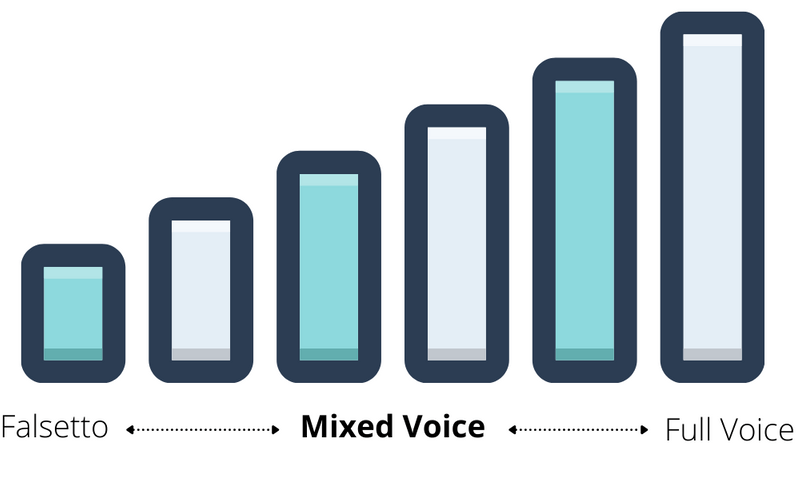How to Sing in Mixed Voice – 4 Steps to Mastery
Mixed voice is one of the most-used voice quality and techniques among singers.
There has been much discussion about the use of mixed voice. It really is not that complicated to sing in mixed voice. Actually, it is quite easy.
You don’t need 2-3 years to learn how to master mixed voice.
If you want to learn how to sing in mixed voice, you are going to love this post.
If you’re ready, let’s dive into this.
Confusion about Mixed Voice
Mixed voice got its name because it’s supposed to have both head and chest resonances, as opposed to the lower register having strong chest resonance and higher register having strong head resonance.
The singer is “mixing” head resonance and chest resonance in mixed voice. I think this definition of mixed voice is a little abstract and confusing for singers.
Another definition of mixed voice is that it is the vocal quality that sits between full voice and falsetto.
Mixed voice is lighter than full voice and heavier than falsetto.

I personally go by this definition, because it is much clearer and more actionable for the singer to execute vocally in a muscular sense (thicker than falsetto and thinner than full voice).
Theoretically, you could sing full voice, mixed voice, and falsetto on any note. Think of them as vocal colors you could use in your singing.
Voice Teachers from the “Mix singing school” advocate that you should sing mixed voice throughout your range, because it is a healthier and more superior vocal quality.
Although I disagree, mixed voice is still a very effective vocal color and quality you could use in your singing.
When to Use Mixed Voice
Just like full voice and falsetto, there is a time and place for you to apply mixed voice for singing. When applied appropriately, it can make your performance and interpretation very effective.
So, when should you use mixed voice:
1. When the music calls for it.
Think of mixed voice as a particular vocal color that you can use in your songs.
As I said, it is fuller than falsetto and lighter than full voice.
If you are trying to express an intimate personal feel, you can use mixed voice.
Listen to the chorus of “I Knew I Loved You” where Darren Hayes sings the high notes with his beautiful mixed voice:
Try different vocal colors when you sing your songs.
Within mixed voice, you can even be a little stronger or softer.
You just need to try it out to see what fits your song.

2. When you can’t hit the high notes in full voice.
I did mention above that there is a stronger and fuller version of mixed voice.
If you want to sing high notes that you can’t quite hit with full voice, you can use a harder version of mixed voice.
If you do it correctly, you could even “disguise” it as full voice in your high notes.
Listen to Taiwanese singer Terry Lin sing his high notes in mixed voice:
There are singers who sing high notes in mixed voice for an entire career. There’s nothing wrong with it as it’s a personal choice or preference for the singer.
Further reading: How to Sing Higher For Men – No More Cracking!
3. When you want to strengthen your voice for full voice training.
When you can’t hit the high notes in full voice yet, mixed voice is the best alternative.
In a muscular sense, mixed voice is applying more vocal cord closure and depth than falsetto does, which moves the voice more towards full voice.
You can strengthen your “mixed voice muscles” to prepare for full voice training.

For example, you can sing the high C in mixed voice and try to add more vocal weight to train for hitting it in full voice.
4 Simple Steps to Sing Mixed Voice
Singing mixed voice is not as difficult as people think. There are some voice teachers who tend to complicate things and make it sound harder than it actually is.
I’m going to share with you how to sing and train your mixed voice in 4 simple steps.
Here they are:
Step #1: Find your “focused falsetto.”
If you want to sing mixed voice, you have to find your focused falsetto first.
Now, what do I mean by focused falsetto?
Most singers have airy falsetto that lack vocal quality. Falsetto doesn’t have to be airy and weak. It can be very focused and pure.
Focused meaning there’s no air leakage.
Here’s how you do it:
First, sing “yeh” with a tiny falsetto on a C4 for male, and for female, start on F4.
Second, slide down an octave and back up to the same note.
Listen to it
Third, move up a half step to C#4 (male) or F#4 and repeat.
Keep moving up in half-step increments until it gets too high.
Remember to keep the focused quality on the tiny falsetto – it has to be on a very soft volume.
Try to feel a little “buzz” at the roof of the mouth at all times. If the buzz is there, you are doing it right. If not, try again.

Step #2: Add vocal weight to falsetto.
Vocal Coach Thomas Appell calls this the “Messa Di Voce exercise,” and Jaime Vendera calls this the Transcending Tone.
First, sing a focused falsetto on a C4 for both male and female.
Then, slowly change the vocal quality by adding more vocal weight.
This is usually done by increasing the volume. Make sure there is a qualitative change in tonal color.
Listen to it
Finally, move up in half-step increments and repeat until it gets too high.
Step #3: Practice reinforced falsetto with Ee scream.
This exercise is taught by Jaime Vendera and his teacher Jim Gillette. It is very effective in strengthening the vocal cords to come together more.
For me personally, reinforced falsetto in a form of mixed voice, because it can be so strong that heavy metal singers use it to sing super high notes.
Here how you train it, and it’s quite easy:
First, sing a focused and tiny falsetto with the Ee vowel on E4.
Then, swell it or make it louder (crescendo), but stay on falsetto instead of going to full voice.
Listen to Jaime Vendera explain and demonstrate how it’s done:
Finally, move up in half-step increments and repeat.
Step #4: Use mixed voice in a song.
After you have practiced mixed voice in the exercises above, it’s time to apply it to songs. After all, that’s what we’ve practiced for!
Choose a song with high notes that you can’t sing with full voice.
Sing those high notes with mixed voice.
Sometimes the mixed voice might sound a little weak.
Use the reinforced falsetto instead with the pingy and focused tone you practice with the Ee Scream.
The mixed voice is a great alternative when you can’t quite hit the high notes with full voice.
Further reading: 13 Best Signing Techniques to Improve Your Voice Instantly
Best Mixed Voice Training Online
If you want to develop your mixed voice for advanced singing, you’ll need a complete training program.
There are so many online courses that teaches how to sing in mixed voice. It is hard to distinguish which one is good.
In my opinion, one of the best voice teachers that teaches mixed voice singing is John Henny.
I’m a big fan of his works for many years.
His flagship training New Science of Singing 2.0 uses practical vocal science to effectively train the mixed voice.
It is the most reliable program on mixed voice training, as opposed to all the fluff you see online about mixed voice.
Things to Watch Out for with Mixed Voice
Before I end this post, I would like to share with you some things you need to watch out for.
Here they are:
1. Mixed voice is not full voice.
There are many voice teachers who claim that mixed voice is legitimate full voice. I can assure you it is not.
You could train it to sound like full voice, but there is still a subtle difference in tonal color.
My advice is that you train your mixed voice as best as you can. But, train your full voice as well – you need both.
2. Mixed voice is not everything.
There is a Mix singing school that started in the last century that has become the most popular singing methodology in modern times.
Voice teachers from that camp train singers to sing mixed voice in low, middle, and high range, as well as all singing styles.
While it is great to focus on one vocal chop, mixed voice is technically not enough for singers to sing a wide range of musical styles.
Falsetto, mixed voice, and full voice are all vocal colors that you can use to better interpret your songs. You need to train all of them.
3. Use mixed voice tastefully.
I sing almost 99% in full voice. I use falsetto and mixed voice for stylistic expressions, but that’s about it.
It all depends on what you want to sing. If you’re a female classical singer, or you want to sing Bee Gees or Prince type of music, then mixed voice or falsetto is definitely the way to go.
With all that’s said, mixed voice is still very useful and every singer needs to train it.
What Do You Think? Let Me Know…
Did you find this post about mixed voice useful?
Is there anything I missed or you disagree with?
Leave a comment below and let me know what you think.
I’d love to hear from you and discuss with you.






